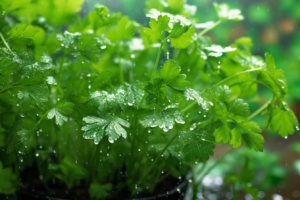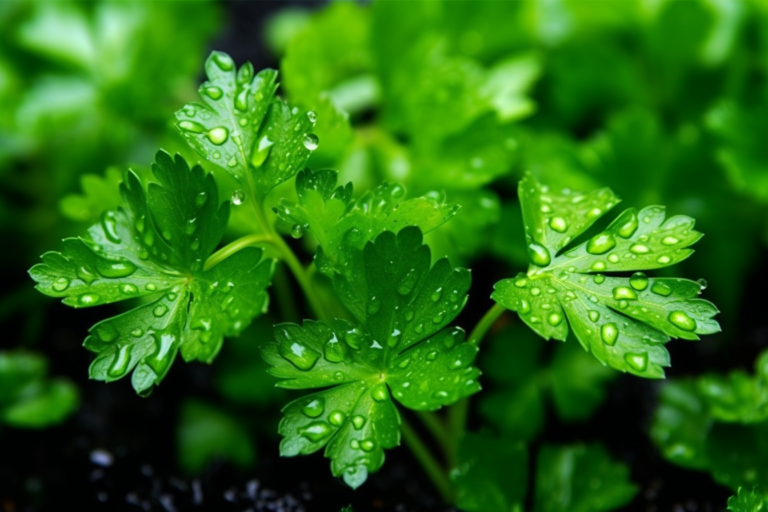Cilantro, also known as coriander, is a popular herb with a fresh, citrusy flavor, widely used in various cuisines around the world. In this guide, we will explore how often to water cilantro, ensuring that you maintain a healthy, thriving plant. Let’s dive in!
Understanding Cilantro’s Water Requirements
Cilantro prefers consistently moist soil, but not too wet. It’s crucial to strike a balance between keeping the soil moist and avoiding waterlogged conditions, which can lead to root rot and other issues. So, how can we find that sweet spot?
The Role of Climate
Climate plays a significant role in determining how often cilantro needs water. In hot, dry climates, cilantro will need more frequent watering, whereas cooler, more humid environments will require less. Always be mindful of your local climate when deciding on a watering schedule.
The Importance of Soil and Drainage
Soil Type
The type of soil you plant cilantro in is essential for its overall health. A well-draining soil mix will help prevent waterlogged conditions and ensure that the plant receives the right amount of water. A mix of loamy soil, compost, and sand is ideal for cilantro.
Container vs. Ground Planting
Cilantro grown in containers will require more frequent watering than those planted in the ground. This is because containers can dry out more quickly, especially in hot weather. Be sure to use a well-draining potting mix and a container with drainage holes to avoid overwatering.
Indoor vs. Outdoor Cilantro
Cilantro can thrive both indoors and outdoors. However, indoor plants generally require less water, as they are not exposed to the sun and wind like outdoor plants. Monitor the soil moisture regularly and adjust your watering schedule accordingly.
Watering Frequency: Factors to Consider
There is no one-size-fits-all answer to how often you should water cilantro. Instead, consider the following factors when determining your watering schedule:
- Climate
- Soil type and drainage
- Container vs. ground planting
- Indoor vs. outdoor growth
Seasonal Adjustments
Adjust your watering schedule according to the changing seasons. During hot summer months, cilantro may require more frequent watering, while in cooler months or seasons with more rainfall, you can reduce the frequency.
Signs of Overwatering and Underwatering
Keep an eye out for signs that your cilantro is receiving too much or too little water. Overwatered cilantro may have yellowing leaves, wilted growth, and root rot. Underwatered cilantro will exhibit dry, crispy leaves and slow growth.
How to Properly Water Cilantro
When watering cilantro, water the plant deeply, ensuring that the water reaches the root zone. Allow the soil to dry slightly between waterings, but never let it dry out completely. Here are some tips for proper watering:

- Water in the morning: This allows the plant to utilize the water throughout the day and prevents the growth of mold and mildew.
- Water at the base: Aim the water at the base of the plant to ensure the roots receive the moisture they need and to minimize water waste.
- Check soil moisture: Before watering, check the soil’s moisture by sticking your finger about an inch into the soil. If it feels dry, it’s time to water.
How Often to Water Established Cilantro Plants
Once cilantro plants are well established, watering frequency can be reduced. At this stage, the plants’ roots should have reached a depth of several inches into the soil, and they are more efficient at extracting moisture from the soil. Overwatering established cilantro plants can lead to root rot and other fungal diseases, which can severely damage or kill the plants.

The ideal frequency for watering established cilantro plants depends on various factors such as soil type, weather, and pot size. As a general guideline, it is recommended to water cilantro plants every 3-4 days in moderate temperatures and average humidity levels.
It’s important to observe the soil regularly to determine when to water the cilantro plants. The top inch of the soil should be allowed to dry out before the next watering, but the soil underneath should still be moist to the touch. Over time, you will develop a feel for the soil’s moisture levels and will be able to adjust the frequency accordingly.
During the summer months or in hot and dry climates, cilantro plants may require more frequent watering. In such cases, it’s recommended to water the plants every 2-3 days or as soon as the top layer of soil becomes dry. It’s also beneficial to add mulch around the base of the plant, which can help retain moisture in the soil.
To avoid overwatering, it’s essential to ensure adequate drainage in the pot or soil. The soil should not be soggy or waterlogged, and any excess water should be allowed to drain away properly.
In summary, watering established cilantro plants every 3-4 days is generally recommended, but this frequency may vary depending on the weather, soil type, and pot size. It’s essential to observe the soil regularly to determine when to water the plants and avoid overwatering or underwatering.
How to Adjust Watering Frequency for Cilantro Seedlings
Growing cilantro is a rewarding experience, but it can be tricky to figure out the best watering frequency. Cilantro seedlings have different needs than mature plants, so it’s important to adjust your watering routine accordingly. In this section, I’ll share some tips on how to adjust your watering frequency for cilantro seedlings.

Water Seedlings Carefully
When starting to grow cilantro from seeds, it’s essential to be mindful of watering. Overwatering or underwatering can cause damage to delicate seedlings. Start by ensuring that the soil is moist but not soaked before planting the seeds. Afterward, aim to keep the soil consistently moist at all times.
Monitor Soil Moisture Level
Monitoring the soil moisture level is the key to adjusting your watering frequency for cilantro seedlings. Use a moisture meter or stick your finger in the soil to check the moisture levels regularly. Cilantro prefers consistently moist soil but not soggy. If the soil feels too dry, it’s time to water, but if it’s still moist, hold back on watering for a while.
Adjust Watering Frequency as Seedlings Grow
As cilantro seedlings grow taller and develop more leaves, they will need more water to thrive. Increase the watering frequency by watering the soil from the bottom, ensuring that the plant roots get enough water deep down. However, be careful not to water too frequently or too heavily, as this can cause root rot.
Reduce Watering Frequency for Established Seedlings
When cilantro seedlings develop into mature plants, they can tolerate dry soil better than when they were seedlings. By the time they are six weeks old and have matured, cut back on watering to once a week or even less often if the soil drains slowly.
Remember, overwatering or underwatering your cilantro seedlings can cause root rot or stunted growth. Always adjust your watering routine as your cilantro grows, and monitor soil moisture frequently to ensure you are giving them the appropriate amount of water. With proper watering, you can enjoy a bountiful harvest of fresh cilantro leaves all season long.
Signs of Overwatering and Underwatering Cilantro
To avoid damaging your cilantro, it’s essential to watch for signs of over or under-watering. Wilting or yellowing leaves can be a sign of over or underwatering. If the soil feels too dry, cilantro needs watering. In contrast, a waterlogged soil surface or a moldy aroma can be an indication of overwatering. It’s crucial to check the soil’s moisture level in between watering to ensure consistent moisture levels.
How to Water Cilantro
When watering cilantro, it’s essential to aim for the soil but avoid getting water on the foliage. Watering directly onto the leaves can cause damage and increase the risk of disease. One effective method of watering cilantro is to use a drip irrigation system, as it delivers water directly to the soil without wetting the foliage.
Best Time to Water Cilantro
The best time to water a cilantro plant is early in the morning. Watering in the morning allows the plant to fully absorb the water before the heat of the day, reducing the risk of evaporation. Watering in the evening can lead to excess moisture on the leaves overnight, increasing the risk of disease and fungus growth.
In conclusion, watering cilantro correctly is crucial for optimal growth and flavor. Keep in mind the frequency, signs of over and underwatering, and techniques for correctly applying water. By following these guidelines, you can grow healthy and delicious cilantro in your garden or kitchen.
FAQS
What is the ideal soil type for cilantro?
Cilantro prefers a well-draining soil mix, such as a combination of loamy soil, compost, and sand.
How can I tell if my cilantro is overwatered or underwatered?
Overwatered cilantro may have yellowing leaves, wilted growth, and root rot. Underwatered cilantro will exhibit dry, crispy leaves and slow growth.
Is it better to grow cilantro indoors or outdoors?
Cilantro can thrive both indoors and outdoors. Consider your climate, available space, and personal preferences when deciding where to grow cilantro.
How do I adjust my watering schedule for seasonal changes?
During hot summer months, cilantro may require more frequent watering, while in cooler months or seasons with more rainfall, you can reduce the frequency. Always monitor soil moisture and adjust as needed.
How deep should I water cilantro?
Water cilantro deeply, ensuring that the water reaches the root zone. This promotes a healthy, robust root system and helps the plant absorb essential nutrients.


This article was really helpful in understanding how often to water cilantro. I used to water it every day and wondered why it kept dying, but now I know to only water it when the top inch of soil feels dry. Thanks for the tips!
I always struggled with how often to water my cilantro, but this blog post provided really helpful information. Thanks for sharing!